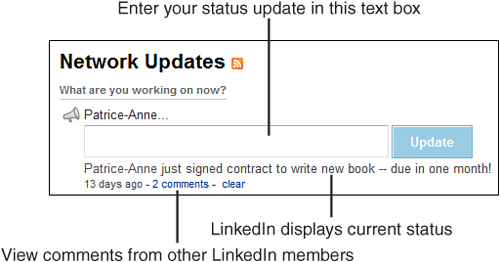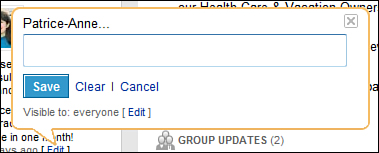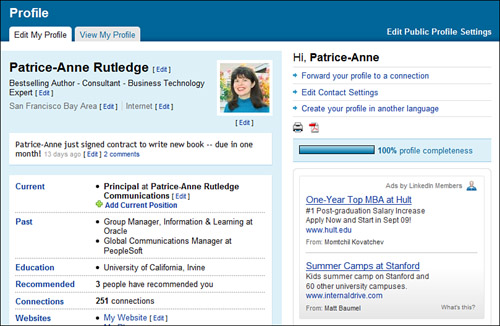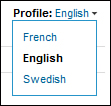In this lesson, you’ll learn how to update your LinkedIn status and profile, promote your profile on the web, create a profile in another language, and print and download your profile.
Keeping your profile current is critical to your success on LinkedIn. Creating your initial profile may be a one-time task, but you need to update it regularly to let others know you’re an active participant on LinkedIn. In addition to updating your actual profile, LinkedIn enables you to post frequent status updates to inform your network about your activities and accomplishments.
LinkedIn status updates let you communicate important news to LinkedIn members in 140 characters or less. When you update your status, this text appears on your profile and on the Network Updates section of your connections’ home page.
Brevity is the key to a status update: You need to express important information concisely. You can include links in status updates but no text formatting. If you’re familiar with Twitter, you’ll understand the concept of brief text updates. However, unlike Twitter, LinkedIn doesn’t display a list of all your prior updates. Your status update remains on your profile indefinitely until you either delete it or replace it with a new status update.
Although status updates are a fun way to let your connections know what’s new in your life, they are also a strategic networking tool. Keep your goals in mind and post updates that help achieve them. Here are some examples:
• Michelle Andrews is recruiting SAP business analysts.
• Anna Romanova just posted a new blog entry: 10 Tips for Healthcare Marketing http://bit.ly/15LcqU.
• Sam Wong is planning a career change to executive coaching.
• Patrice-Anne Rutledge just released her latest book, Sams Teach Yourself LinkedIn in 10 Minutes.
Caution: Avoid Sales Pitches in Your Status Updates
Although a well-crafted status update can be an effective marketing and publicity tool, avoid overt sales pitches in your status updates. A status update is a conversation with your network, not an advertisement.
Tip: Use a URL Shortening Service to Include Links in Your Status Updates
If the link you want to include in your status update exceeds the 140-character limit, you can use a URL shortening service. bit.ly (http://bit.ly) is one service that shortens URLs and tracks how many people click on your link.
The fastest way to update your status is in the Network Updates section on your home page (see Figure 5.1).
Enter your status in the text box labeled What Are You Working on Now? and click the Update button.
Alternatively, you can use the status update pop-up box to update your status. You can access this box in two ways:
• Click the What Are You Working On? link in the profile summary box below the left navigation menu. If your status already appears, click the Edit link.
• Click the Edit My Profile link on the expanded left navigation menu. Then click the What Are You Working On? link at the top of your profile. Again, if you have a current status, this link is replaced with the Edit link.
Figure 5.2 illustrates the status update pop-up box.
Enter your status in the text box and click the Save button.
The Visible To field tells you who can view your status updates. If you want to change this, click the Edit link next to this field to open the Status Visibility page.
On this page, you can specify whether you want your status updates visible to your connections, to your network, or to everyone. Click the Save Settings button to save your changes.
Tip: Use Status Updates to Gain Exposure Across the Entire LinkedIn Network
Unless you have specific privacy concerns or communicate information pertinent only to your own connections, allowing everyone on LinkedIn to view your status updates provides the maximum exposure.
To delete a status update, click the Clear link below your status on your home page or in the status update pop-up box. Entering a new status update also removes your previous update.
Tip: Update Multiple Social Networks at Once
If you update your status on multiple social networking sites, consider using a free service such as Ping.fm (http://ping.fm). Ping.fm enables you to simultaneously post updates to sites such as LinkedIn, Facebook, and Twitter.
When your status appears in your connections’ Network Updates section on their home page, they can enter their own comments by clicking the Add Comment link below your status update. They can also send you a private message by clicking the Reply Privately link.
If your connections have entered comments about your status update, you’ll see a link beneath your posted status update on your home page and on your profile. The link tells you how many comments you have (for example, 2 Comments). Click this link to view your comments and add your own feedback to the discussion.
Even if you create a thorough profile when you first sign up for LinkedIn, you’ll eventually want to update it with recent information.
You should update your LinkedIn profile whenever your employment status changes, you receive a degree or certification, win an award, learn a new skill, start a new business, achieve a career milestone, or change your LinkedIn goals. To update your profile, click the Edit My Profile link in the expanded left navigation menu. The Profile page opens with the Edit My Profile tab active, shown in Figure 5.3.
The Edit My Profile tab is the same place you first created your profile, so you should already be familiar with its content. After you first enter profile data, links such as Add Past Position or Add Education disappear. Instead, click the Edit link next to any field you want to update. The appropriate LinkedIn page opens, where you can make any required changes.
You can also click the Current, Past, Education, Recommended, Connections, and Website links to enter data or make changes in those sections.
See Lesson 2, “Creating Your Profile,” for more information about the content you can enter on the Edit My Profile tab.
Caution: Don’t Let Your Profile Get Outdated
Although it’s not necessary to update your profile every week, you shouldn’t let it get outdated either. If it’s obvious that you haven’t touched your profile in months, or years, LinkedIn members might not bother contacting you for what could have been a lucrative opportunity for you.
With your permission, LinkedIn makes a public version of your profile available for view and search on the web. Figure 5.4 shows a sample LinkedIn profile link in Google search results.
Tip: Promote Your LinkedIn Profile in Print
Although promoting your profile online is most common, many LinkedIn members also print their LinkedIn profile URL on business cards, brochures, and other marketing materials.
To customize the appearance of your public profile, click the Account & Settings link on the top navigation menu and click the Public Profile link on the Account & Settings page.
Lesson 2, “Creating Your Profile,” provided details on how to manage your public profile. As a reminder, here are tips to maximize your profile’s online visibility:
• Customize your public profile URL to make it user-friendly, such as http://www.linkedin.com/in/patriceannerutledge.
• Select the Full View option on the Public Profile page and place a check mark next to all fields you want to appear on your public profile.
• Preview your public profile to ensure that you like how it appears to others on the web.
In addition to maintaining a public profile, you can also post a LinkedIn button on your website, blog, or online resume. Figure 5.5 shows a sample button.
Click the Customized Buttons link on the Public Profile page to open the Promote Your Profile! page, where you can select the button style you prefer. LinkedIn offers a special button for TypePad users, but you can place your button on any blog or website. For example, a blog sidebar is a great place for a LinkedIn button. Copy the HTML code LinkedIn provides and paste it into your own site.
A third way to promote your LinkedIn profile on the web is to include a link to your public profile URL on the following:
• Your email signature
• Your online business card
• Other social sites, such as Technorati, Naymz, and Facebook
Tip: Promote Your LinkedIn Profile on Facebook
If you use Facebook (www.facebook.com), consider installing the My LinkedIn Profile application on your Facebook profile.
English is the primary language on LinkedIn, but LinkedIn is a decidedly international network with more than half its members residing outside the United States. In Europe, for example, LinkedIn is the number one professional networking site in 43 countries. To meet the needs of its many international members, LinkedIn offers several foreign language features.
The LinkedIn interface is available in four languages: English, French, Spanish, and German. To view LinkedIn in another language, click the Language link on the top navigation menu and select your preferred language. Figure 5.6 shows the LinkedIn interface in French.
Keep in mind that even if you view the LinkedIn interface in another language, this doesn’t translate the user-generated content of an individual member’s profile. The profile content remains in the original language the member used to create it.
To display your profile content in another language, you need to create a profile in that language. For example, someone involved in international business or residing in a country with more than one official language might want to create profiles in multiple languages.
To create a profile in another language, follow these steps:
- Click the Edit My Profile link on the expanded left navigation menu.
- Click the Create Your Profile in Another Language link, which appears at the top of the right column of the Edit My Profile tab. The Create Your Profile in Another Language page opens.
- Select the language for your profile from the Language drop-down list. LinkedIn currently supports more than 40 languages. To create a profile in a language that LinkedIn doesn’t support, select Other.
- Enter your First Name, Last Name, and a Former/Maiden Name, if applicable.
- Enter your Professional Headline.
- Click the Create Profile button to return to the Edit My Profile page.
- Enter your profile content in your target language, just as you did for your English-language profile.
LinkedIn members can choose to view your profile in another language by selecting their preferred language from the Profile drop-down list in the upper-right corner of your profile, shown in Figure 5.7.
You can print and download your profile, or the profile of another LinkedIn member, by clicking one of the icons in the upper-right corner of a profile, shown in Figure 5.8.
Your options include
• Print This Profile. Opens the Print dialog box in which you can specify print options and print a profile.
• Download as PDF. Creates a PDF document from your profile that you can view with Adobe Reader (get.adobe.com/reader).
• Download vCard. Downloads your profile in the vCard format, which is a file format used for electronic business cards. This option appears only for your own profile or for your connections.







